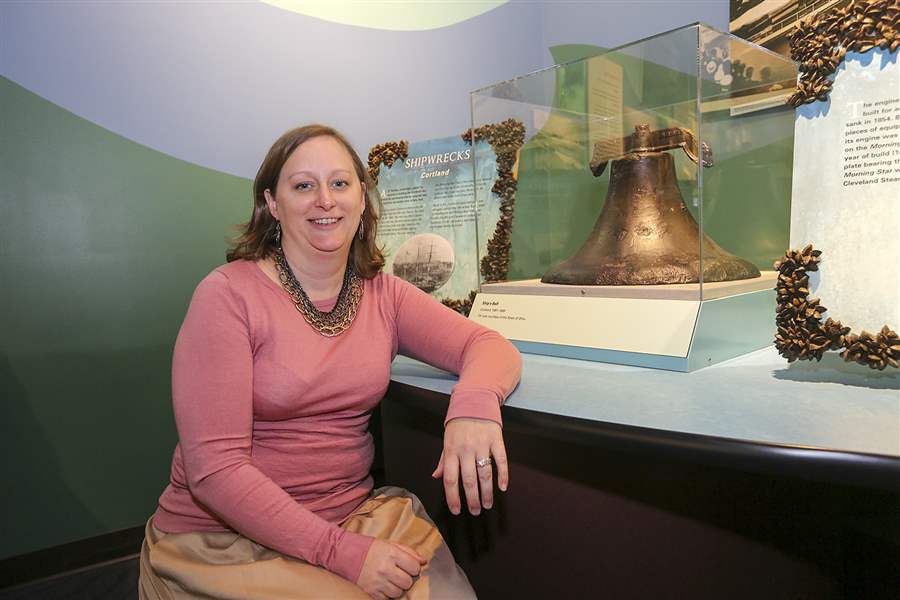
CLASSES COMING TO TOLEDO AREA IN APRIL
Diver shuns med school for thrill of underwater finds
3/28/2017
Carrie Sowden, a nautical archeologist, leans next to an iron bell that she recovered from the Cortland, which sank off Lorain, Ohio, in Lake Erie, in 1868 and killed 35 people. The bell is now at the National Museum of the Great Lakes.
THE BLADE/JETTA FRASER
Buy This Image
Carrie Sowden wasn’t always on a path to be an underwater archaeologist, but she’s thrilled to have docked in Toledo.
As a college student, Ms. Sowden searched for an internship that would allow her to spend a summer in Maine, where her family vacationed. She spent a few months preserving artifacts from a 1710 shipwreck.
One year later, she wondered if she could make a career out of it.
“All of a sudden, I was like, ‘That was really cool. I could do that. Med school sounds lame,’ ” Ms. Sowden said. “So it was this random, unexpected thing, but it’s turned out really well for me.”
Before joining the National Museum of the Great Lakes as its archaeological director, Ms. Sowden, 41, received degrees from Emory University and Texas A&M University. She traveled as far as Portugal and Turkey, diving to the depths of the seas studying shipwrecks.
The diving component is little more than a means of transportation for Ms. Sowden. Finding what lies beneath is the real reward.
“There’s just something about boats that have been present and permanent in human nature for literally thousands of years,” she said. “There’s so much they can tell you about the culture and the people who built it, sailed it, and perhaps died on it.
“I’ll be down there just working away, and all of a sudden I’ll have to stop and think about what I’m really doing. I’m sitting on the edge of this boat that 150 years ago was above the water with a bunch of people on it. This isn’t just numbers and measurements I’m taking, which does mean something, but in the end, it's about the people and the greater story.”
Every shipwreck Ms. Sowden encounters tells a different, yet important tale.
She ventured to the bottom of the Red River in Oklahoma to examine the state’s only shipwreck. The steamboat built in New Albany, Ind., was carrying goods from Cincinnati when it sank just a few miles from its destination.
“It’s interesting because the guys who were shipping the goods, their contract said they didn’t get paid until they made it to dock,” Ms. Sowden said.
While in Turkey, Ms. Sowden analysed tin ingots from the Uluburun. The ship sank in 1305 B.C., and each ingot was engraved with the owner’s mark.
Ms. Sowden discovered a new owner’s mark that had not been found previously.
The most interesting item she recovered is a bell on display at the museum. The bell was on board the Cortland, which sank in 1868 off the coast of Lorain, Ohio, in Lake Erie, killing 35 people.
Most bells on ships were made of brass, but Ms. Sowden was surprised to find this one was made of iron. She discovered it was originally on the ship owner’s farm in Seneca Falls, N.Y.
“People will be like, ‘Oh, did you find gold?’ ” Ms. Sowden said. “But some of the things we do find are super interesting. Archaeology is all dependent on the questions you’re asking.”
Those interested in an up-close-and-personal experience with a shipwreck can take Ms. Sowden’s workshop. The three-part class is designed for divers and nondivers, and begins April 29.
Participants will learn about laws and ethics, research, and do their own shipwreck survey in May.
“The people who go through the class, it gives them an ownership of Great Lakes shipwrecks,” Ms. Sowden said. “It’s a piece of history they now know. I really enjoy teaching people about what the Great Lakes have to offer.”
John McCarty, the museum’s chief operating officer, said the program brings in many out-of-towners.
“Doing the programs here now and being able to attract people is big for us,” he said. “The actual diving is a limited opportunity. It’s good for the museum — they’re here for the dive portion — but they see the museum, see the ship, and that creates an opportunity for those kinds of visitors to come back.”
To register for the workshop, go online http://bit.ly/2mxYNzW.
Contact Jay Skebba at: jskebba@theblade.com, 419-376-9414, or on Twitter @JaySkebbaBlade.